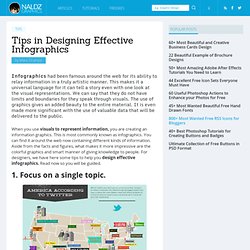

20+ Tools to Create Your Own Infographics. A picture is worth a thousand words – based on this, infographics would carry hundreds of thousands of words, yet if you let a reader choose between a full-length 1000-word article and an infographic that needs a few scroll-downs, they’d probably prefer absorbing information straight from the infographic. What’s not to like? Colored charts and illustrations deliver connections better than tables and figures and as users spend time looking back and forth the full infographic, they stay on the site longer. Plus, readers who like what they see are more likely to share visual guides more than articles. While not everyone can make infographics from scratch, there are tools available on the Web that will help you create your very own infographics.
In this article, we’re listing more than 20 such options to help you get your messages across to your readers, visually. Read Also: The Infographic Revolution: Where Do We Go From Here? What About Me? “What About Me?” 12 Most Intriguing Uses of Infographics. Infographics are everywhere. It seems as if they stormed out of the very recent Internet-connected past. But if you think about it, the illustrated flow charts cavemen must have drawn on stone walls to demonstrate how to track and kill a wooly mammoth were really just infographics.
They just weren’t called that back then. What the latest technology and design allow, however, are many wonderful new uses for these handy, attractive conveyors of data. Here are 12 that I really love. 1. Adding graphics to annual reports is, of course, not new. 2. Maybe this one isn’t for everyone. 3. When done well, a summary of professional skills and experiences spiffed up with graphics and other design hallmarks of infographics, can be very powerful. 4. Usually, when a report is turned into an infographic, it’s just an executive summary. 5. So, would you read a white paper on a disorder called Convergence Insufficiency? Tips in Designing Effective Infographics. Infographics had been famous around the web for its ability to relay information in a truly artistic manner.

This makes it a universal language for it can tell a story even with one look at the visual representations. We can say that they do not have limits and boundaries for they speak through visuals. The use of graphics gives an added beauty to the entire material. It is even made more significant with the use of valuable data that will be delivered to the public.
When you use visuals to represent information, you are creating an information graphics. 1. Image: inboxq First thing to consider is to have a single topic for an infographic. 2. Image: princeton Since you are creating something to convey a message, you have to make sure that it is not over designed that it makes the information complicated. The Do's And Don'ts Of Infographic Design. Advertisement Editor’s Note: You might want to read Nathan Yau’s article The Do’s And Don’ts Of Infographic Design: Revisited1 here on Smashing Magazine which is a response to this article.

Since the dawn of the Internet, the demand for good design has continued to skyrocket. From Web 1.0 to Web 2.0 and beyond, designers have remained on their toes as they define the trends and expectations of our online universe. The Internet is a great designer’s playground, and online businesses are growing more and more appreciative of what can be gained from a bit of well-executed eye candy. Over the past two years, this fact has become the backbone of a growing trend in online marketing: the infographic. Infographics are visual representations of information, or “data viz” as the cool kids call it these days. Of course, just as Web 2.0 changed 1.0, today’s infographics are far more eye-catching than simple pie charts and bar graphs. Wrapping Your Mind Around Data Viz Show, Don’t Tell Tell a Story (al)
Infographic. Information graphics or infographics are graphic visual representations of information, data or knowledge intended to present complex information quickly and clearly.[1][2] They can improve cognition by utilizing graphics to enhance the human visual system’s ability to see patterns and trends.[3][4] The process of creating infographics can be referred to as data visualization, information design, or information architecture.[2] Overview[edit] Infographics have been around for many years and recently the proliferation of a number of easy-to-use, free tools have made the creation of infographics available to a large segment of the population.

Social media sites such as Facebook and Twitter have also allowed for individual infographics to be spread among many people around the world. In newspapers, infographics are commonly used to show the weather, as well as maps, site plans, and graphs for statistical data. "Graphical displays should: Graphics reveal data. History[edit] Early[edit]